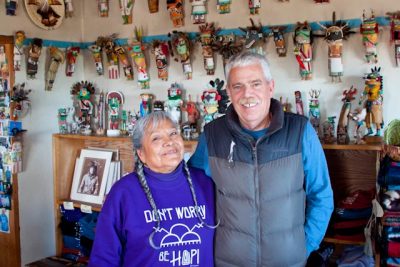
My wife Janice, AKA the boss, who is Hopi, owns a small shop called Tsakurshovi on the outskirts of the Hopi village of Songòopavi and that is where we both work. A substantial part of our business is local Hopi and Navajo people because we carry many things that local folks need. We have moccasins–real ones, not the kind one sees for tourists along the Interstates–as well as mineral pigments, horse hair, cottonwood root for Katsina doll carvers, buckskins, fox skins, awls for basket makers, medicinal herbs, and a host of other things.
Some things we sell are so strange that our non-native customers don’t even know what they are or what they are used for unless we tell them. When was the last time anyone saw culinary ash or turkey beards for sale at the local mall?
We also get non-native tourists passing through on their way to or from Cańon de Chelly National Monument, Grand Canyon N.P., Monument Valley Tribal Park, and some who are actually visiting the Hopi Rez on purpose, since some of the Hopi villages are the oldest continually occupied settlements in the United States.
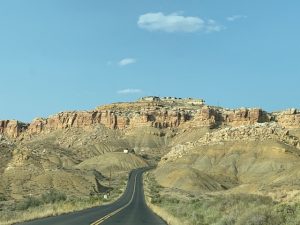
My wife’s village is 1,000 years old and some of the stone Hopi villages look just like the great cliff dwellings at Mesa Verde N.P. and are just as old. The only difference between Mesa Verde and some of the Hopi villages is that instead of being built into the cliff sides of the mesa, Hopi villages are built on top of the mesa and instead of being abandoned, people still live in the Hopi villages.
Since Janice and I both work in the shop, but not always at the same time, sometimes I’m in the shop by myself when a tourist comes in. I can tell, by even the most subtle of double takes, that they are surprised to see someone who is as white, bright, and sticks out like a sore thumb as me. Some are cool and careful and ask, “Are you a Hopi”? My reply is always to pull up my sleeve, flash my white arm, and say, “I don’t know, take a good look, whaddaya think”? However some just blurt out,” what are YOU doing here,” as if i was some kind of capitalist pig colonial invader exploiting the poor red man. My reply to this varies but always includes, “I’m practicing the old Hopi custom of living at your wife’s place, and my wife Janice is the owner of the shop and the Hopi in the family.” Usually this calms them down.
After tourists begin to feel more comfortable with my presence, whether Janice is there or not, the questions start: “How did you two meet?” and “How long have you been married?” If Janice is in the shop I usually tell them, “Ask her,” and her replies are usually, “My brother dragged him home” and “forty three miserable years,” and we laugh and say, “That’s the short version. The long version is so good that we charge to tell it.” In fact, that’s what I have been telling Stiles ever since he started badgering and begging me to write about “how you two kids met,” three issues ago. I can’t stand it anymore so here goes…..
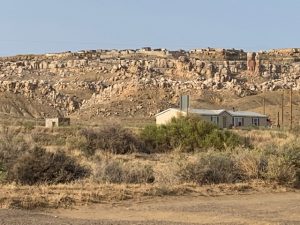
When I left living in a hogan on the the Navajo Rez in the mid ’60s, (See last issue’s “The Missionary Position,”) I moved to suburban Philadelphia for something completely different. I worked there for three years.
I really enjoyed the east coast, which was a pretty exciting place in the late ’60s, but I got lonesome for the high desert, red rocks, and wide open spaces of the southwest. I mean Pennsylvania is nice but you really can’t see anything for all those damn trees.
So I decided the field trip was over and moved to Flagstaff Arizona in 1970, close to everything I missed back east. I took a job as the director of Flagstaff’s three Headstart Centers. At the center where my office was, we always had six or seven Navajo four year olds who came to the center speaking no English, only Navajo. My Navajo language skills were rudimentary at best and I thought there should be someone there they could talk to, so I advertised for a Navajo speaking teacher’s aid. A young Navajo woman applied for the job and I hired her.
I noticed that she had a long last name that was unrecognizable to me and definitely not Navajo, and when I asked her about it, she said she was married to a Hopi. I met her husband, Joe, we became friends, and he invited me to a Katsina ceremony at his village. I am now his brother-in-law because he is the brother spoken of in Janice’s “my brother dragged him home” comment.
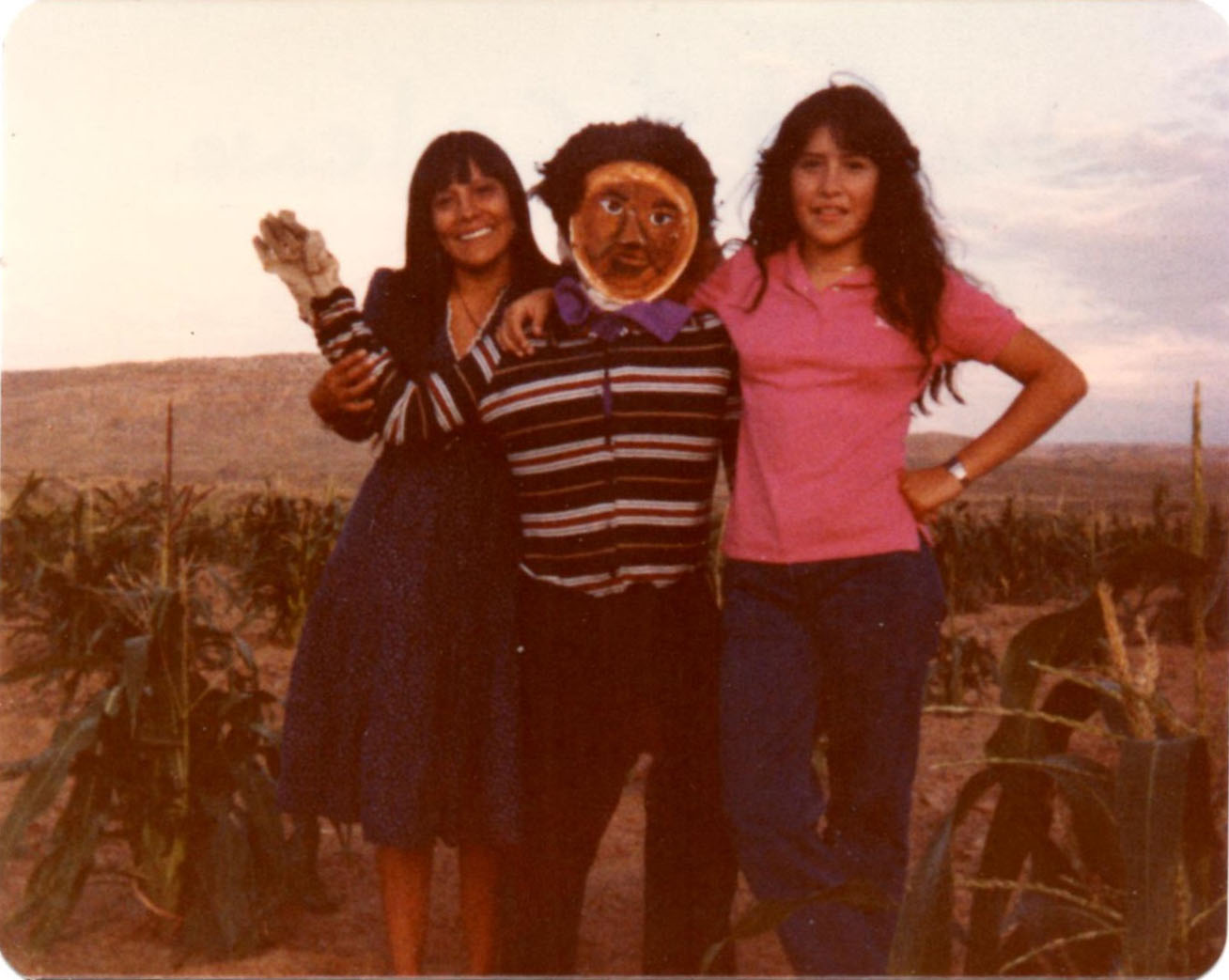
Through Joe, I met his father, brothers and sisters, aunts and uncles, and assorted other family members and became a frequent visitor to the Hopi rez for ceremonies and other occasions. However his sister, Janice, was living and working in Phoenix and I really didn’t know her.
Now jump ahead to 1976. I was back living in Flagstaff after a couple of years in rural southern Arizona, where I kept my friendships at Hopi and was a pretty regular visitor, and now, back in Flagstaff, even a more frequent visitor. That was when Joe’s sister Janice, who had been living in Phoenix for ten years, came to her senses and decided that she was a failure as a “white lady” in the suburbs and decided to move home to the Rez. Phase one of moving to the Rez was getting her job to transfer her to Flagstaff and that is where we met.
Janice and I had a lot in common, I mean most of my Hopi friends were her relatives! She was beautiful and I was, in her words, “kinda cute.” Janice remembers fireworks but all I remember was the daze and, when we moved in together in Flagstaff, how we were immediately the talk of the town and a hot topic of gossip, a high Hopi art form.
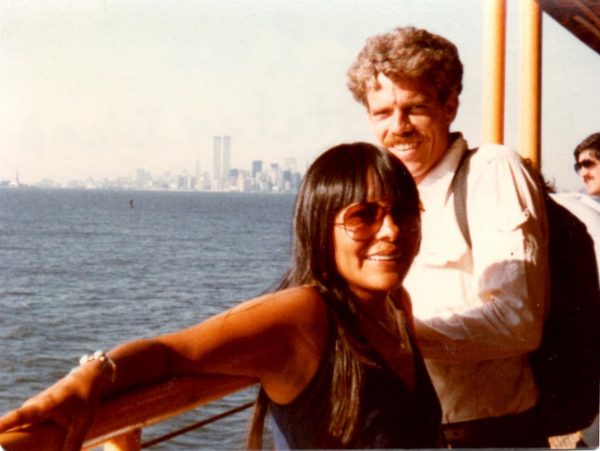
Janice’s father, a man who I’d known for eight years, whose house I stayed in when I visited the Rez, and who stayed with me when he came to town, asked Janice, “are you shacking up with that “hippie”? However he continued to stay with me, now us, and he never expressed his disapproval to me and we continued to interact as we always had.
And that brings up a question we always get which is, “How was I/how am I accepted at Hopi?” My short answer is always, “I don’t know. You have to ask my in-laws.” And then I tell the Freda So’o story.
Freda So’o was called so’o/grandmother, not in the blood-related sense but because she was a respected old lady from Janice’s father’s clan. She was an 85 year old four-foot-ten real “Anasazi” lady from Paaqavi Village. There was a Katsina ceremony at Kiqotsmovi Village and, because So’o didn’t drive, we went to pick her up in our car. When we got to Paaqavi, Freda So’o asked if we could also take her friend Hovensi, another 85 year old Hopi lady, So’o size, to the dance. We said sure and she joined Freda So’o in the back seat.
As we were driving to Kiqotsmovi, I heard them in the back seat talking in Hopi, as most old folks usually do. Hovensi asked Freda, “Who’s the Pahaana?” Pahaana being the word for Euro-American white folks like me. Freda replied in Hopi, “That’s Janice’s husband,” to which Hovensi replied, “Well, at least she didn’t marry a Navajo.” Considering the past conflicts between Hopi and the surrounding Navajo, I considered it a compliment.
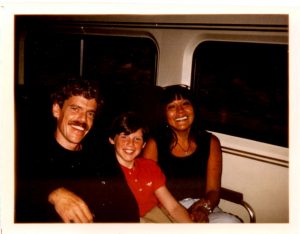
As for most of my Hopi friends, many of whom were now my in-laws, they were already used to me, so there was not much of a problem. I knew how to behave, kept my mouth shut, didn’t ask too many dumb Pahaana questions, could chop wood and build a fire, learned how to do traditional Hopi dry land farming, understood and respected the ceremonies, and tried to fit into this non-western non-English speaking very different culture, so different than my own, as best I could. You’ll have to ask my in-laws about how well this went. Unfortunately none were interviewed for this story. But as Janice’s cousin Tim replied when I was complaining about my luck one day, “I think you’re pretty lucky, you’re in a room full of Indians and we’re not beating you up.”
That being said, did I suffer culture shock? Had I met Janice in Phoenix with no knowledge or experience of Hopi and had we gotten together and moved directly from my culture to hers, there would have been some major surprises and culture shock for me, for sure. Because I had been coming to Hopi for seven years and knew Hopi people and a little about their culture, I was spared most major culture shock. Janice and I lived in Flagstaff for a few years before moving to the Rez and that probably helped as well. Like most “urban” Hopis, even though we lived in town we spent many weekends going “out home”, as Hopis call the Rez, to take care of family responsibilities and to attend ceremonies.
After living on the Rez for thirty five years, longer than I’ve lived anywhere, I now feel at home here and I think I function as well as a Pahaana can here. Again, you’ll have to check with my in-laws about that.
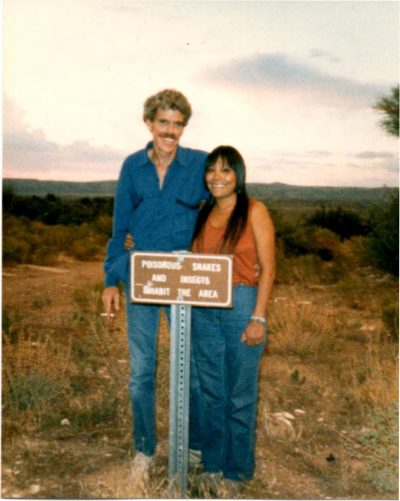
Sometimes visitors ask me if I’ve become more Hopi and my reply is always, “No, I’ve become more Pahaana.” For instance, Janice thinks I sometimes talk too much to Pahaana customers and she’s right, I sometimes do. I always remind her that, if one lives as a minority in a community, it’s important to be able to assert one’s Cultural Identity and I love speaking my native language with other native speakers. She smiles and rolls her eyes. Cultural respect is a two way street. If I am to respect Hopi culture, and I do, then Hopis need to respect mine as well. It is important for everyone to be able to assert who we are and understand that culture is not something we can take off and put on like changing a shirt, no matter the pressure to totally assimilate. And that pressure to assimilate exists, no matter where you are. If you don’t believe me, ask a first or second generation immigrant.
That being said, I do sometimes have a Hopi reaction to what’s happening around me. I’ve been here too long not to. I involuntarily do what’s called code switching and it always surprises me, and Hopis around me, when I do it. Sometimes I verbally react/code switch in Hopi and sometimes I even do it in what I call “Hopi” English. I once said “laters” to a young man leaving the shop and he turned to me and said, “You’re the only Pahaana I know who says laters.” I’m also probably the only Pahaana he knows who sometimes mutters “iss ohi” in disapproval, no matter where I am or who I’m with. I like to think of myself as semi-bicultural rather than culturally confused but it may be a little of both. Janice, having been born and raised in Flagstaff because her father didn’t want his kids to suffer through a brutal substandard education in a B.I.A. school like he did, is semi-bi cultural as well. Maybe more so, since she has spent more time in the Pahaana culture than I have in hers.
She’s so tuned in that she will sometimes pull me aside when I’m relating an event to another Pahaana when we’re in the Pahaana world–say, in Flagstaff–and whisper, “Get to the point. You’re telling this story like a Hopi.” And what she means by “like a Hopi” is this: If you ask a Hopi farmer why he uses a certain kind of plant to make wind breaks in his field, the answer would go something along the lines of, “When the first world was created,” continue with all the events in that first world plus the two succeeding worlds, move on to the emergence into the current fourth world, and end with, “and that’s why my uncle told us to always use this plant for making our wind breaks.” She understands Pahaana culture so well that she knows that the average Pahaana, interested in instant gratification, just can’t take it. They start to to fidget with the need to check their phone messages or their Fakebook Page to get that dopamine flowing again or, even worse, start to nod off.
And that reminds me, dear reader, that I better put an end to this rambling screed in hopes that I have satisfied your and Stiles’ interest in, as he so aptly put it in his constant badgering, “how you two kids met.” Little did he know that he wasn’t the first one to ask.
Joseph Day was raised on the plains of Kansas, but he’s lived for decades on Second Mesa in Arizona’s Hopi Reservation. He and his wife Janice run the Tsakurshovi store on Second Mesa.
Click Here to Read More of Joseph Day’s “Dispatches from the Rez…”
To comment, scroll to the bottom of the page.
Zephyr Policy: REAL NAMES ONLY on Comments!
Don’t forget the Zephyr ads! All links are hot!
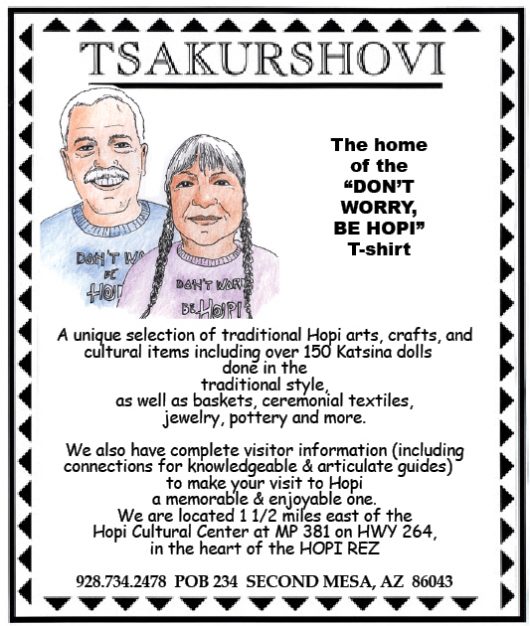






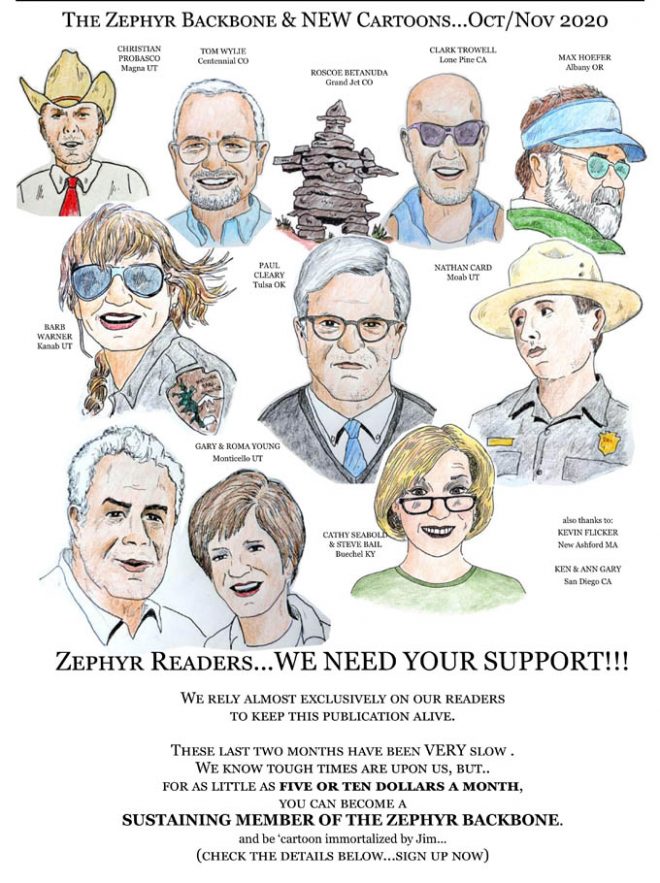
Ahem, In the picture of Janice in the cornfield, the other woman in the photo is not Janice’s sister but rather our daughter, Celena.
Thanks for reading!
Joseph day
WOW, I’m dealing with a real person, not a computer, for a refreshing change of pace. The publisher actually read my comment and changed the caption using some kind of instant inter-nest magic to fix the caption on that photo. I’m happy, Janice is happy, and Celena didn’t even notice the mistake. Thanks Ms T!
Joseph Day
? White vs Hopi…. it may shock you but Hopi are Listed in anthropology as “Caucasians”!
Heya, love to read a little about your son, Jonathan. The last I knew he was an authority on Kachina dolls and very respectful and generous in sharing that information. ms
Another great piece, but one thing drives me crazy: What does the sign in the caption for “Our favorite rest area sign in Arizona” caption say?
Looks like “Poisonous Snakes and Insects Inhabit the Area”
Mary Sojourner here again. I’d love to get in touch with Jonathan. Please give him my email. Thank you. ms
Enjoyed reading this, just stumbled upon it reading about Hopi people when we were watching documentary Time of Prophecy. Found an article from 1995 about Pet Bahana and then led me here 😆